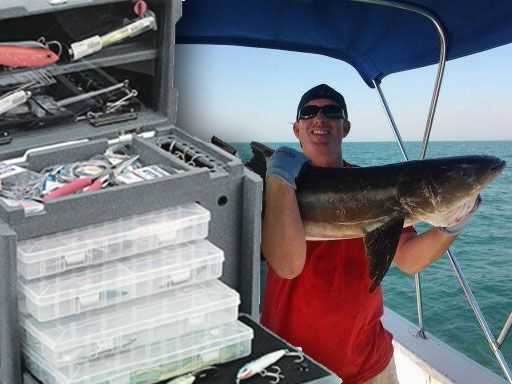Well, it’s the time of year to get your cobia tackle ready, because they will be showing up very soon! Last year, we saw the first schools arrive in the area during the last two weeks of April. Who knows what might happen this year, with the way our mild winter has been keeping the water temperatures up? It would not surprise me at all if we don’t see some cobia being caught at the first of this month. The most important factor is the bait—if it shows up early the cobia won’t be far behind. So, don’t be caught without your lures and rigs ready to go.
Lures
Here’s what you want to make sure tohaveontheboatasyougoouttofind some cobia action. Blue Water Candy Bucktails and Spro Bucktails are some of the best cobia jigs you can buy. Your tackle box should have an arrangement of sizes including two-ounce, three- ounce and four-ounce. Some of the most productive colors are White, Chart/White, Chart, Orange, Pink/ Chart, Pink/White, Pink, Purple and Mylar. They all work very well, but you need an assortment of colors, because you just never know what color might be working on that day. So, it is always a good idea to have options in your bag. When using a bucktail, you always want to rig a six-to-eight-inch curlytail on it. Got-cha Grubs and Berkley Gulp are some of the best. Something that worked great on the bucktails last year was the Gulp Eels in 8 inch and 10 inch in the Black, Black Shad and Natural colors. These eels also will work well when just using them on a cobia rig. The Power-Bait Eels in the eight-to-ten-inch sizes that come pre-rigged with two hooks work great, too. The cool thing about them is they are already rigged and ready to fish!
Something new this year is the Blue Water Candy Mamma Jama two and three ounce Bucktail Spinner Combo. It’s an all-mylar bucktail with a willowleaf blade attached to the hook with a ball- bearing swivel. They come in White and Chart Mylar. This thing is going to be a killer around bait balls! I can’t even imagine what this thing will do when you drop it through a bait ball and the blade just flutters down, looking like wounded bait. You won’t need a curlytail or anything else—just cast it and let it do all the work. You can also buy the spinners with the ball bearings for them separately, allowing you to put them on bucktails you already own.
Rigs
First, what you want to use for bottom fishing for cobia around the inlets and deep holes in the area are menhaden, crabs or mullets. You are going to need some 80- to 100-pound leader material, either mono or fluorocarbon. Both will work fine. The big difference is that fluorocarbon will completely disappear in the water and mono doesn’t. But it’s a little more costly than mono leader material. Some say it’s not worth the extra cost but it does give an extra advantage. You want to make your leader around 6-8 feet long.
You don’t have to make them that long, but added length does help when you have a big cobia on yours. You have to remember that cobia can get very large and are wild fish when you hook them. The main benefit of the long leader is so that his tail does not swing around and cut the leader causing you to lose your fish. Some good brands of leader material are Seaguar, Big Game, Yo- Zuri, Momoi and Ande.
Hook size needs to be between 7/0 and 9/0, either a “J” hook or a circle hook. Some good brands to use are Gamakatsu, Owner and Eagle Claw. They all work very well. You are going to need a good swivel in the 100- to 150-pound class range—Billfisher or Spro swivels will both work fine.
One of the main components for making a good cobia rig is to have a “fish-finder.” I get asked all the time, “What is a fish-finder and how does it work?” It’s just a small component that you slide onto your main line off your reel, and it has a clip on it that allows you to hook a weight to it. The benefit of having the fish-finder is it allows the cobia to come up and take your bait and swim off a few feet and never feel the weight or you on the other end. This gives you time to set the hook on the fish before he realizes what’s going on. So, your weight stays right on the bottom and your line will come off your reel and slide right through the fish-finder, allowing the fish to take the bait without feeling anything.
The proper weight size really can vary due to where you are fishing. You want to make sure you are holding on the bottom and that your bait is not down rolling all over the bottom. I would say the best size in this area would be 5-8 ounces. The pyramid weight usually works the best because it holds in the current.
[easy-social-share]
